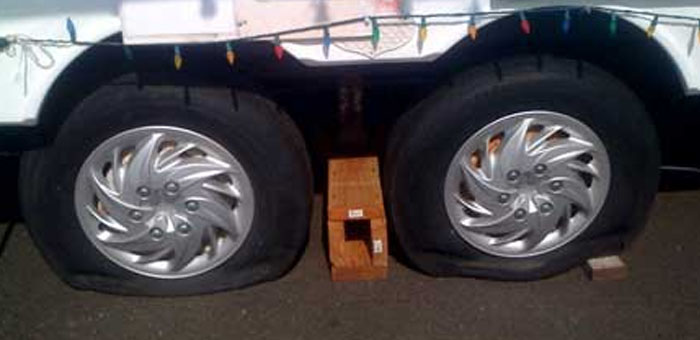Food truck tires may seem like a minor subject when talking about a mobile food business, however, if you think that way, you would be incorrect.
Because you make your living when your food truck can make it onto the streets, you should check your food truck tires for wear at least once a month. To determine whether you need to buy new tires, have your wheels balanced, have your wheels aligned, or change your driving habits, simply read your tire treads for clues. The table below will show you what to look for.
Checking Your Food Truck Tires for Wear
| Clue | Culprit | Remedy |
| Both edges worn | Under inflation | Add more air; check for leaks |
| Center treads worn | Over inflation | Let air out to manufacturer’s specifications |
| One-sided wear | Poor alignment | Have wheels aligned |
| Treads worn unevenly, with bald spots, cups, or scallops | Wheel imbalance and/or poor alignment | Have wheels balanced and aligned |
| Erratically spaced bald spots | Wheel imbalance or worn shocks | Have wheels balanced or replace shocks |
| Edges of front tires only worn | Taking curves too fast | Slow down! |
| Saw-toothed wearpattern | Poor alignment | Have wheels aligned |
| Whining, thumping, and other weird noises | Poor alignment, worn tires or shocks | Have wheels aligned or buy new tires or shocks |
| Squealing on curves | Poor alignment or under inflation | Check wear on treads and act accordingly |
To determine what’s causing problems with your food truck tires, try the following:
- Look for things embedded in each tire. Do you see nails, stones, or other debris embedded in the treads? Remove them. But if you’re going to remove a nail, first make sure that your spare tire is inflated and in usable shape.
If you hear a hissing sound when you pull a nail, push the nail back in quickly and take the tire to be fixed. If you aren’t sure whether air is escaping, put some soapy water on the hole and look for the bubbles made by escaping air. If you’re still not sure whether the nail may have caused a leak, check your air pressure and then check it again the next day to see whether it’s lower. Food truck tires with leaks should be patched by a professional. If the leak persists, get a new tire.
- Look at the sidewalls. Check for deeply scuffed or worn areas, bulges or bubbles, small slits, or holes. Do the tires fit evenly and snugly around the wheel rims?
- Look at the treads. Most tires have tread-wear indicators built into them. These bars of hard rubber are normally invisible but appear across treads that have been worn down to 1/16th of an inch of the surface of the tire (the legal limit in most states). If these indicators appear in two or three different places, less than 120 degrees apart on the circumference of the tire, replace the tire.
If your food truck tires don’t show these indicators and you think that they may be worn below legal tolerances, place a Lincoln penny head-down in the groove between the treads. If you can see the top of Lincoln’s head, your tire probably needs to be replaced.
To measure tread wear more exactly, place a thin ruler into the tread and measure the distance from the base of the tread to the surface. It should be more than 1/16 inch deep. (Note: If your front food truck tires are more worn than your rear ones and show abnormal wear patterns, you probably need to have your wheels aligned.)
- Pay attention to leaks. If you keep losing air in your tires, have your local service station check them for leaks. Sometimes an ill-fitting rim causes a leak. The garage has a machine that can fix this problem easily.
If the garage can’t find a leak, your rims fit properly, and you’re still losing air, you probably have a faulty tire valve that’s allowing air to escape. You can buy tire valves to replace the ones on your car. Look for the number molded into the base of the tire valves; then buy new ones that match it.
In the process of replacing the valve, you will lose most of the air from the tire, so either plan to do this job at a gas station where you can have access to an air hose, or have a mechanic replace the valve for you.
Follow these steps and procedures to better insure your chances of keeping your food truck on the road as much as you possibly can.
Do you have any additional tips about checking food truck tires for wear? We’d love to hear your suggestions. Facebook | Twitter




